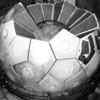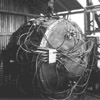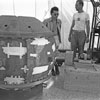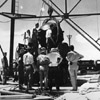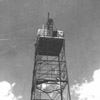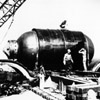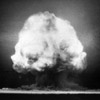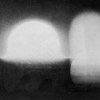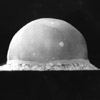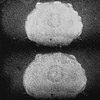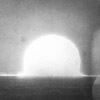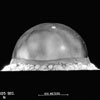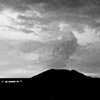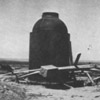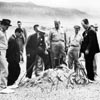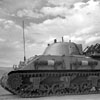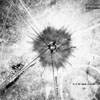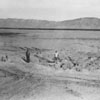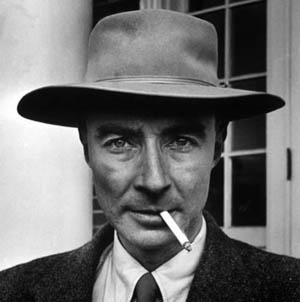
J. R. Oppenheimer
|
Trinity was the code name of the first nuclear weapons test of an atomic bomb. This test was conducted by the United States Army on July 16, 1945, at a location about 56 km southeast of Socorro, New Mexico, at the White Sands Proving Ground, now the White Sands Missile Range.
The Trinity test was the culmination of three years of intensive work by the Manhattan Project at a cost of US$2 billion ($22 billion in present day value). Formally designated as the Manhattan Engineer District (MED), the project was control by the U.S. Army Corps of Engineers headed by General Leslie R. Groves. The scientific research was directed by American physicist J. Robert Oppenheimer.
A gun-type weapon using uranium had already been developed. In this design, one mass of U-235, the "bullet," is fired down a barrel into another mass of U-235, rapidly creating the critical mass of U-235, resulting in an explosion. The method was so certain to work that no test was required.
The second device under development was the implosion type bomb. This used explosive lenses to produce a perfectly spherical explosive wave which compressed a plutonium sphere into a super critical mass. Because of the complexity of an implosion-style weapon, it was decided that, despite the waste of fissile material, an initial test would be required.
The device was referred to as the 'gadget' reflecting its experimental nature. The laboratory's weapon physics division being dubbed 'G Division'. At that time it did not refer specifically to the Trinity Test device as that had yet to be developed, but once it was, it became the laboratory code name. The Trinity bomb was officially a Y-1561 device, as was the Fat Man used later in the bombing of Nagasaki. The two were very similar, though the Trinity bomb lacked fusing and external ballistic casing. The bombs were still under development, and small changes continued to be made to the Fat Man design
The Test Site
After rejecting other parts of New Mexico, an unused Mojave Desert Army base near Rice, California, was considered the best test location. General Groves selected the Alamogordo Bombing Range because George S. Patton controlled the California base. In the fall of 1944, soldiers started arriving at Trinity Site to prepare for the test. Sgt. Marvin Davis and his military police unit arrived at the site from Los Alamos on 30 December 1944. This unit set up initial security checkpoints around the area, and throughout 1945, other personnel arrived at Trinity Site to help prepare for the bomb test. Two bunkers were set up to observe the test. Oppenheimer and Brig. Gen. Thomas Farrell watched from a bunker 16 km from the detonation, while Gen. Leslie Groves watched at a bunker 27 km away.
Test Predictions
The observers set up betting pools on the results of the test. Predictions ranged from zero (known as a fizzle) to 18 kilotons of TNT (predicted by physicist I. I. Rabi, who won the bet), to destruction of the state of New Mexico, to ignition of the atmosphere and incineration of the entire planet. This last result had been calculated to be almost impossible, although for a while it caused some of the scientists some anxiety.
Test preparation
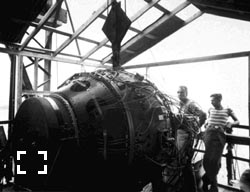
Fully assembled Gadget
|
There was a pretest explosion of 108 tons of TNT, spiked with 1000 curies of fission products from the Hanford reactor, on May 7 to calibrate the instruments. For the actual test, the plutonium-core nuclear device, nicknamed the gadget, was hoisted to the top of a 30 meter tall steel tower for detonation. The height would give a better indication of how the weapon would behave when dropped from an airplane, as detonation in the air would maximize the amount of energy applied directly to the target, and minimilize nuclear fallout.
The plutonium was driven to Trinity site on July 11th in the back of Plymouth sedan. The high-explosive sphere, approximately five feet in diameter, followed lashed to the bed of an Army truck. The device was assembled by Rudolf Peierls at the nearby McDonald Ranch House on July 13. After assembly, it was precariously winched up the tower the following day.
General Groves had ordered the construction of a massive steel canister shapped like a thermos flask code-named 'Jumbo'. The gadget was to be placed inside so that if the test failed, the enormously valuable plutonium could be recovered. The container had walls 38cm thick and weighed 214 tons, which at the time was the largest single object moved by rail. Oppenheimer decided to abandon it since he was confident that the test would work and did not want to corrupt measurements of the explosion. This was a wise decision since the blast would have vapourised jumbo throwing an additional 214 tons of radioactive steel particles into the air. Instead, it was placed in a steel tower 730 m from the gadget as a rough measure of how powerful the explosion would be. In the end, Jumbo survived, though its tower did not.
Photography
Approximately fifty different cameras had been set up, taking motion and still photographs. Special Fastax cameras taking 10,000 frames per second would record the minute details of the explosion. Spectrograph cameras would record the wavelengths of light emitted by the explosion, and pinhole cameras would record gamma rays. Some observers brought their own cameras despite the security. Segre brought in Jack Aeby with his 35 mm Perfex 44, who took the only known well-exposed color photograph of the detonation.
A number of rolls of 35mm Pan-X black & white film were exposed known as 'Newsreel rolls'. These 35mm films were run in trusty Mitchell cameras, running at a range of speeds with various lens's and aperture sizes. Despite guesses on what would be required to capture the event, this was the birth of an entirely new branch of photography.
The detonation was initially planned for 4:00 am but was postponed because of rain and lightning from early that morning. It was feared that the danger from radiation and fallout would be greatly increased by rain, and lightning had the scientists concerned about accidental detonation.
The Explosion

Trinity 16th July 1945
|
At 4:45 am a crucial weather report came in favorably, and at 5:10 am the twenty-minute countdown began. Most top-level scientists and military officers were observing from a base camp 16 km southwest of the test tower. Many other observers were around 32 km away, and some others were scattered at different distances, some in more informal situations. Physicist Richard Feynman claimed to be the only person to see the explosion without the dark glasses provided, relying on a truck windshield to screen out harmful ultraviolet wavelengths. The final countdown was read by physicist Samuel K. Allison.
At 05:29:45 local time (Mountain War Time), the device exploded with an energy equivalent to around 20 kilotons of TNT. It left a crater of radioactive glass in the desert 3 m deep and 330 m wide. At the time of detonation, the surrounding mountains were illuminated "brighter than daytime" for one to two seconds, and the heat was reported as "being as hot as an oven" at the base camp. The observed colors of the illumination ranged from purple to green and eventually to white.
The roar of the shock wave took 40 seconds to reach the observers. The shock wave was felt over 160 km away, and the mushroom cloud reached 12 km in height. After the initial euphoria of witnessing the explosion had passed, test director Kenneth Bainbridge commented to Los Alamos director J. Robert Oppenheimer, "Now we are all sons of bitches." Oppenheimer later stated that while watching the test he was reminded of a line from the Hindu scripture the Bhagavad Gita: Now I am become Death, the destroyer of worlds..
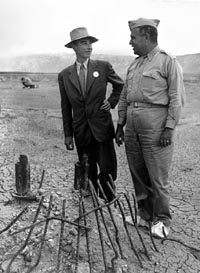
Oppenheimer and Groves inspect the tower remains
|
In the official report on the test, General Farrell wrote, "The lighting effects beggared description. The whole country was lighted by a searing light with the intensity many times that of the midday sun. It was golden, purple, violet, gray, and blue. It lighted every peak, crevasse and ridge of the nearby mountain range with a clarity and beauty that cannot be described but must be seen to be imagined..."
News reports quoted a forest ranger 240 km west of the site as saying he saw "a flash of fire followed by an explosion and black smoke." A New Mexican the same distance north said, "The explosion lighted up the sky like the sun." Other reports remarked that windows were rattled and the sound of the explosion could be heard up to 320 km away.
John R. Lugo was flying a U.S. Navy transport at 3,000 m, 48 km east of Albuquerque, en route to the West Coast. "My first impression was, like, the sun was coming up in the south. What a ball of fire! It was so bright it lit up the cockpit of the plane." Lugo radioed Albuquerque. He got no explanation for the blast, but was told, "Don't fly south."
In the crater, the desert sand, which is largely made of silica, melted and became a mildly radioactive light green glass which was named Trinitite. The crater was filled in soon after the test.
The Alamogordo Air Base issued a 50-word press release in response to what it described as "several inquiries" that had been received concerning an explosion. The release explained that "a remotely located ammunitions magazine containing a considerable amount of high explosives and pyrotechnics exploded," but that "there was no loss of life or limb to anyone." A newspaper article published the same day stated that "the blast was seen and felt throughout an area extending from El Paso to Silver City, Gallup, Socorro, and Albuquerque." The actual cause was not publicly acknowledged until after the August 6 bombing of Hiroshima.
Around 260 personnel were present, none closer than 9 km. At the next test series, Operation Crossroads in 1946, over 40,000 people were present.
The official technical report (LA-6300-H) on the history of the Trinity test was not released until May 1976.
First deployment
Following the success of the Trinity test, two bombs were prepared for use against Japan during World War II. The first, dropped on Hiroshima, Japan, on August 6, was code-named "Little Boy", and used uranium-235 as its fission source. It was an untested design but was considered very likely to work and was considerably simpler than the implosion model. It could not be tested because there was only enough uranium-235 for one bomb. The second bomb, dropped on Nagasaki, Japan, on August 9, was code-named "Fat Man", and was a plutonium bomb of the type tested at Trinity.

| - DNA 6028F - Defense Nuclear Agency report - Trinity
|
|
- Click on a thumbnail for a larger version
|
|









